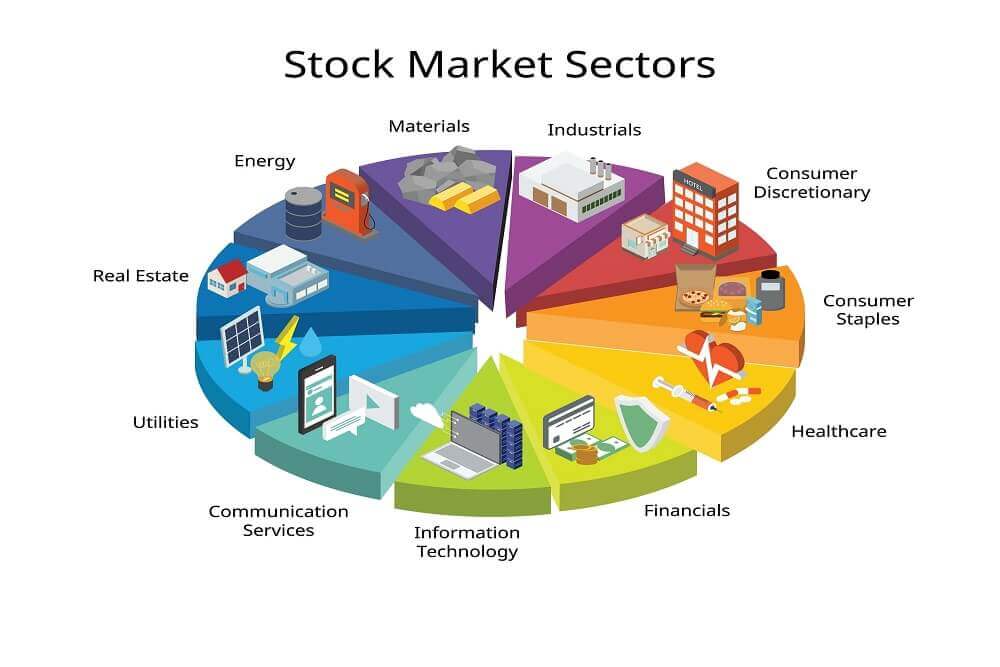Stock market sectors put the stock market under different companies, depending on their primary businesses. That way, investors can adequately diversify their investments and gain a good grasp of the performance in various segments of the market.
By investing in stocks and funds from different industries, not only do you reduce the associated risk, but you’re also raising your chances of turning a solid profit and achieving excellent financial growth.
Stock Market Sectors Explained
Stock market sectors bring together public companies that operate in the same or related industries or have similar business models. The sectors are also subdivided into narrower segments by industry.
There are currently 11 stock sectors under the Global Industry Classification Standard (GICS). The 11 primary sectors currently comprise 24 industry groups, 69 industries, and 158 sub-industries.
Note that the 11 sectors are not permanent and can be changed. The real estate sector, for instance, was included in 2016, signaling growth in the residential and commercial space.
Here is a further look into the GICS’s 11 stock market sectors.
Energy
The energy sector consists of publicly traded companies that remove, refine, and transport fossil fuels. That means firms involved in finding, manufacturing, refining, and selling oil and natural gas.
A few examples of these are oilfield service corporations, pipeline and fuel storage firms, and businesses engaging in coal mining. Renewable energy companies are not part of this sector, as they typically fall under the utilities or industrials category.
Examples of energy stocks and funds:
- Exxon Mobil Corp.
- ConocoPhillips Co.
- Energy Select Sector SPDR Fund
- Vanguard Energy ETF
Industrials
The stocks in the industrial sector are owned by companies involved in the production of capital goods, infrastructure creation, and operation of transport. These firms usually include airlines, railroads, logistics companies, and big engineering firms constructing roads, bridges, and ports.
Examples of industrials stocks and funds:
- Union Pacific Corp.
- FedEx Corp.
- Industrial Select Sector SPDR Fund
- iShares US Industrials ETF
Materials
The materials sector covers a list of companies that undertake the extraction or processing of raw materials or production of materials used for manufacturing. These can include businesses that engage in mining, chemicals processing, and construction supply.
Firms that produce or refine metals such as steel and copper also make up the materials sector.
Examples of materials stocks and funds:
- Ecolab Inc.
- Air Products and Chemicals Inc.
- Materials Select Sector SPDR Fund
- Global X Lithium & Battery Tech ETF
Financials
The financial sector is perhaps one of the easiest to explain out of all sectors. If the business mainly involves money, you’re dealing with a financial firm. Most companies in the financial space include banks, brokerage firms, and insurance companies.
Examples of financial stocks and funds:
- Goldman Sachs Group Inc.
- Morgan Stanley
- Financial Select Sector SPDR Fund
- Vanguard Financials ETF
Utilities
Another easy-to-explain sector, the utility sector, comprises stocks from companies that focus on providing and distributing electricity, or ones that supply natural gas to houses and businesses or own and operate water resources.
Utility stocks are excellent if you’re looking for less volatile and less risky investments that can deliver predictable, steady returns in the long run.
Examples of financial stocks and funds:
- American Water Works
- Brookfield Infrastructure Partners LP
- Global X US Infrastructure Development ETF
- iShares Global Infrastructure ETF
Consumer Staples
Consumer staple companies produce and sell products that people need daily, from food and drink to toiletries. The consumer staples sector also comprises alcohol- and tobacco-makers.
Examples of consumer staple stocks and funds:
- Albertsons Companies Inc.
- Coty Inc.
- iShares Russell 1000 ETF
- Consumer Staples Select Sector SPDR Fund
Consumer Discretionary
Consumer demand is at the heart of every company in the consumer discretionary sector. Unlike consumer staple companies, firms in the consumer discretionary sector mainly sell goods that are considered non-essential.
Consumer discretionary stocks include companies that operate brick-and-mortar and e-commerce businesses, like clothing, automobiles, hotels and restaurants, luxury products, and services related to travel.

Examples of consumer discretionary stocks and funds:
- Home Depot Inc.
- McDonald’s Corp.
- Vanguard Consumer Discretionary ETF
- First Trust Consumer Discretionary AlphaDEX Fund
Healthcare
Healthcare companies can be involved in the development and production of pharmaceuticals, or they are providing healthcare services or manufacturing the products used in providing healthcare.
In pharmaceuticals, the firms are either focused on researching and developing drugs or supporting that effort. On the other hand, in health care services, you can find hospitals, medical equipment makers, and health insurance firms. You can also bet on cannabis stocks when investing in the health care sector.
Examples of healthcare stocks and funds:
- Novavax Inc.
- Eli Lilly and Co.
- Health Care Select Sector SPDR ETF
- iShares Biotechnology ETF
Real Estate
Real estate stocks are companies that build and manage huge real estate projects alongside real estate investment trusts (REITs), but not with mortgage REITs, which are under the financial sector.
Examples of real estate stocks and funds:
- Annaly Capital Management Inc.
- SL Green Realty Corp.
- Real Estate Select Sector SPDR Fund
- Schwab US REIT ETF
Information Technology
The information technology sector can be classified into two segments: the software and hardware segments.
Companies that produce computer hardware (e.g., semiconductors, computer and server parts, etc.) mainly make up the sector, while software makers and service providers include well-known database and software firms.
Additionally, stocks of internet companies have been dominating the information technology sector. However, some internet firms have been listed in other sectors due to their businesses. For example, the stock of Amazon.com Inc. is classified under the consumer discretionary sector.
Examples of information technology stocks and funds:
- HP Inc.
- Intel Corp.
- iShares Russell 1000 ETF
- Vanguard Information Technology ETF
Communications Services
Formerly called the telecom sector, the communications services sector consists of two areas. The first area includes wireless network service providers and companies providing landline services.
The second area, the broader part of the sector, comprises media and entertainment firms, such as radio and television companies and interactive media and online entertainment businesses that are growing more and more popular each day.
Examples of communications stocks and funds:
- Live Nation Entertainment Inc.
- Alphabet Inc.
- iShares US Telecommunications ETF
- SPDR S&P Telecom ETF











